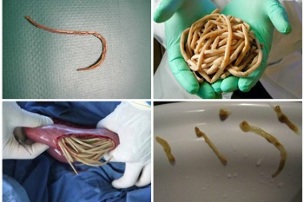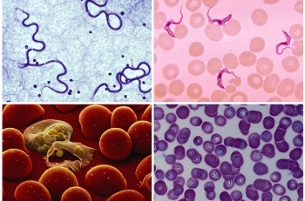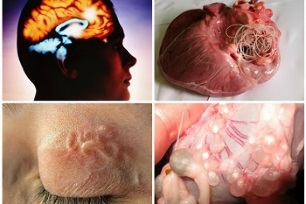There is a risk of worm infestation without even leaving your home. Different types of helminths can be found on household items, banknotes, dishes, food, in drinking water.
Parasites enter the human body in a way that is convenient for them: they can enter the digestive system with food, water, dirty hands or insect bites.
In addition, helminths affect certain internal organs, use the resources of the human body, cause mechanical damage and actively reproduce. Their life processes are accompanied by unpleasant and often dangerous symptoms and damage to various organs.
How to recognize intestinal worms

Intestinal helminthiasis combines a group of diseases caused by worms of different types. It is most often possible to identify ascariasis (ascaris), enterobiosis (pinworms), hookworm disease (hookworm). These parasites live in the lumen of the human intestine, feed on its contents and their presence can be suspected by a number of characteristic symptoms:
- Dramatic weight loss without change in diet and physical activity. Intestinal helminths use the nutrients of the human body as a source of energy for growth and reproduction, and their devices for fixation in the intestine (suckers, hooks) injure its walls and interfere with the absorption of other trace elements. Pain in the stomach, navel, itching in the rectum are caused by the movement of worms, mechanical damage they cause, as well as the release of larvae or adults from the body in the external environment.
- Various digestive disorders: diarrhea or constipation, flatulence, mucus, foam or blood in the stool, nausea, vomiting. In some cases, adult parasites can be found in the stool.
- The human body can react to the appearance of parasites with allergic reactions, the phenomena of intoxication, which are caused by waste products from helminths. More often this is manifested by itchy skin, redness of certain areas, rashes (vesicles, blisters of various sizes).
Diagnosis of intestinal helminthiasis includes faecal examinations, clinical and biochemical blood tests (eosinophilia, leukocytosis) and, if necessary, ultrasound data of the body.
Signs of parasites in the liver
The human liver accumulates a large amount of nutrients, and there is also intense blood circulation, which is convenient for parasites. Common hepatic helminthiasis: fascioliasis, opisthorchiasis, dicroceliosis caused by worms from the group of hepatic flukes.
You can identify them by specific characteristics:

- Acute pain in the right hypochondrium is caused by the mechanical effect of helminths. Thus, echinococcus forms cysts in the tissues of the body, provoking the development of inflammatory processes or even necrosis.
- Adult worms (roundworms) can block the bile ducts, which disrupts the flow of bile, the digestive process in the body is difficult and the patient has signs of jaundice. The visible mucous membranes of a person acquire a yellow tinge, and with the development of the pathology the skin also becomes colored.
- Non-specific symptoms of the appearance of parasites will be deterioration of the general condition of the body, weight loss, nausea, lethargy.
To donate the diagnosis, they donate blood for analysis. Leukocytosis, eosinophilia and biochemical tests will show an increase in the activity of liver enzymes (ALT, AST). During the ultrasound, liver damage will be visible in the body: enlargement, inflammation and in some cases parasitic cysts can be detected.
What does the presence of lung helminths indicate
Some parasites (roundworm, toxoplasma, echinococcus, cenur) can enter the lungs of a person with blood or lymph flow from the gastrointestinal tract. They multiply in the alveoli, which makes it difficult to breathe, and some species (single-chambered echinococcus) form cysts that damage the structure of the organ.
It may be difficult to determine the presence of parasites in the lungs, as the symptoms are similar to those of respiratory diseases of viral and non-infectious etiology (bronchitis, ARVI). Cough, shortness of breath, chest pain, fever indicate the need for further examination of the patient's body.
For the diagnosis of pulmonary helminthiasis, the X-ray method will be the most informative. The images will show lesions in the human body caused by echinococci (cysts) and bovine tapeworm (fibrous formations), which must then be distinguished from neoplasms, cysts of various etiologies and pneumonia.
Blood parasites

Unicellular protozoan worms can be found in the vessel lumen. Babesia, plasmodia (Plasmodium falciparum), trypanosomes, microfilariae, schistosomes cause dangerous diseases that pose a threat to human life.
By destroying the formed elements, they disrupt the processes of energy metabolism in the body and block the supply of nutrients to organs and tissues.
In most cases, human infection occurs after an insect or tick bite. After some time, the body develops signs of anemia: paleness and then cyanosis of the mucous membranes, dizziness, sudden weight loss and deteriorating health. Without timely medical care, blood parasites can pose a serious threat to human life.
Diagnosis involves performing microscopic blood tests, during which single-celled parasites and destroyed erythrocytes can be detected, as well as the type of worm. The treatment is long-term, carried out stationary under the supervision of a qualified doctor.
Unusual Parasite Habitats
Some types of helminths can penetrate the human heart, subcutaneous tissue (heartworms), brain and spinal cord (cysticerci, echinococci). It is possible to become infected not only in exotic countries, but also by eating familiar food that has not been subjected to proper heat treatment, and pets can become carriers. Signs of invasion depend on the degree of damage to a particular organ.
In the brain, worms can form cysts, fibrous formations that cause nerve phenomena.

Headache with unexplained etiology, trembling (trembling) of the limbs, changes in tactile sensitivity, impaired coordination of movements, sharp deterioration of hearing and vision - the signs of invasion depend on the location of worms and their larvae.
Adult parasites can be seen visually under the skin, usually accompanied by itching and tingling, as well as in the eyes, ear canals and other places.What to do if you notice signs of worm infection
Diseases with parasitic etiology are treated under medical supervision after all necessary tests and identification of the type of parasites. Prescribe anthelmintic drugs with a narrow or broad spectrum of action, conduct restorative and symptomatic therapy, promote the removal of worms from the body. In some cases, surgery is indicated.
The prognosis for most diseases is favorable with timely initiation of treatment. If you postpone a visit to the doctor or start taking medication on your own, the healing process can be delayed and many types of parasites can damage vital organs or body systems or even lead to death.



























